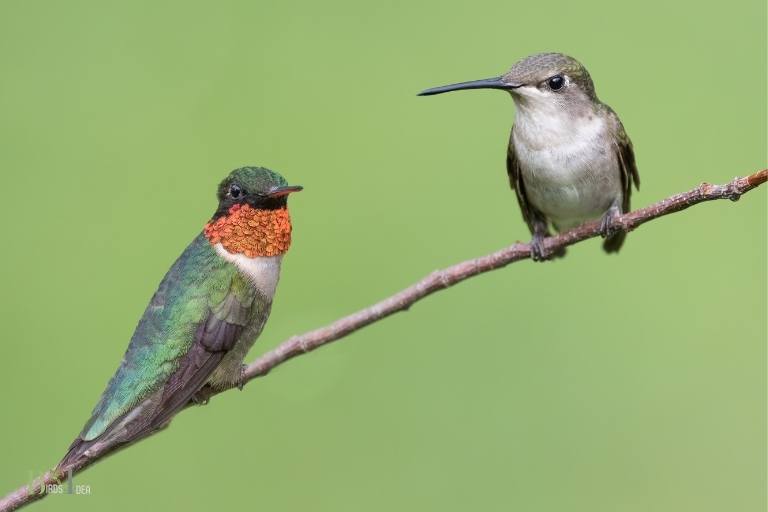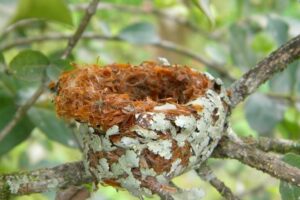How to Tell If a Hummingbird is Male Or Female: Observe!
To tell if a hummingbird is male or female, observe the bird’s size, coloration, and physical characteristics such as throat patches and tail feathers.
Determining the sex of a hummingbird can be done by carefully observing their physical differences. Male and female hummingbirds generally have distinct color patterns, size differences, and unique features that can help differentiate between the two genders.
It’s important to note that some of these characteristics may vary depending on the hummingbird species.
Finally, examining the tail feathers can also provide clues to a hummingbird’s sex. Male tail feathers are often more pointed or forked, while female tail feathers tend to be more rounded and less showy.
6 Indicators Between Male and Female Hummingbirds
| Indicator | Male Hummingbird | Female Hummingbird |
| Color | Brighter, more iridescent colors | Duller, less iridescent colors |
| Throat patch | Bright, flashy throat patch (gorget) in some species | Plain, unmarked throat or spotted/striped throat patch |
| Tail shape | More pointed, shorter tail feathers | Rounded, longer tail feathers |
| Body size | Slightly smaller body | Slightly larger body |
| Behavior | More aggressive, territorial | More cautious, nurturing (feeding young) |
| Mating displays | Perform complex aerial displays and courtship songs | Observe and choose a mate based on displays/songs |
Key Takeaway

Five Facts About: Identifying Hummingbird’s Gender
Understanding Hummingbird Anatomy
Hummingbirds are beautiful and fascinating creatures, known for their unique and speedy movements. These tiny creatures come in various sizes and colours, making it difficult to distinguish between genders and even species.
To determine whether they are male or female, understanding their anatomy is essential.
Here are some things you need to know:
Differences In Physical Features Between Male And Female Hummingbirds
There are several physical differences between male and female hummingbirds that can help you identify their gender.
Here are some of the typical characteristics:
- Male hummingbirds are usually more brightly coloured than females.
- Males have more iridescent feathers on their throat, also known as a gorget, that shimmers when they move.
- Females have larger bodies than males to accommodate their eggs during the breeding season.
- Males have more extended and pointed tail feathers, while females have more rounded and shorter tail feathers.
By observing these characteristics, you can determine the gender of a hummingbird with more accuracy.
Importance Of Observing Physical Characteristics While Identifying Gender
Observing physical characteristics is crucial when identifying the gender of a hummingbird. It helps you avoid making inaccurate assumptions and provides an in-depth understanding of the species-specific features associated with each gender.
The physical characteristics of a hummingbird can also tell us more about their behaviour and breeding habits. For example, male hummingbirds usually have more brightly coloured feathers to attract females during mating season.
Additionally, observing their physical characteristics can help us understand more about their migration patterns and habitat requirements.
Distinguishing Between Different Species Of Hummingbirds
Distinguishing between different species of hummingbirds can be tricky, as there are over 300 species worldwide. Some species look identical but have different migratory patterns, while others have subtle physical differences.
To distinguish between different species, you need to look beyond the physical characteristics and consider their range, habitat, and the time of year you spot them.
For example, the ruby-throated hummingbird is north america’s only species with a bright red throat, making it more easily identifiable than other species.
Observing hummingbirds can be an exciting and rewarding experience. With these tips, you can look beyond the surface and gain a more comprehensive understanding of these fascinating creatures.
Behavioral Differences Between Male And Female Hummingbirds
Hummingbirds are fascinating birds that everyone loves to watch, but do you know the difference between male and female hummingbirds? Let’s investigate the behavioral differences between male and female hummingbirds.
Explanation Of Typical Behaviors Exhibited By Male Hummingbirds
Male hummingbirds possess distinctive behaviors that distinguish them from female hummingbirds.
Here are some behaviors that you might observe in male hummingbirds:
- Male hummingbirds exhibit a higher level of aggression than females, and they are generally more territorial. They often fight to protect their space or food sources, even if no females are present.
- Males tend to be more active and showy when attracting the females. They display their bright colors and flamboyant movements to attract females for mating. They may perform aerial acrobatics, such as impressive dives and climbs, to impress them.
- They typically have a distinctive shape and vibrant colors that help them to attract females. Male hummingbirds generally have a more colorful appearance than females.
An Overview Of Female Hummingbird Behavior Commonly Observed
Female hummingbirds possess unique behaviors that distinguish them from males.
Here are some behaviors that you might notice in female hummingbirds:
- Female hummingbirds are generally more cautious than males. They spend more time assessing their surroundings before venturing out to feed or breed.
- They tend to have a somewhat duller appearance compared to males, which makes them less conspicuous and helps them stay under the radar of predators.
- Females typically spend more time building nests, gathering food, and taking care of their young, while males focus more on finding a mate and defending their territory.
Differences In Mating Behaviors Between Male And Female Hummingbirds
Mating behaviors among hummingbirds vary significantly between the sexes.
Here are some of the differences:
- Males typically initiate courtship by performing impressive aerial displays. They will often fly in front of the female, displaying their colorful plumage to impress her.
- Females usually choose a mate based on the male’s display performance. Once she has made her decision, they mate quickly and disengage.
- After mating, the female is responsible for building the nest and laying the eggs. The male does not contribute any care to the offspring.
The behavioral differences between male and female hummingbirds are significant. Males tend to show more aggressive and showy behavior while females are more cautious and have duller colors.
Understanding these differences can help you appreciate and enjoy these fascinating birds even more.
Identifying Male Hummingbirds
Hummingbirds are fascinating creatures with over 300 species spread out across the globe. You may come across these feathery fellows in a variety of sizes and colors, but do you ever wonder if you’re looking at a male or a female?
If you’re interested in learning how to identify a male hummingbird, keep reading. We’ll explore the physical characteristics that set them apart from their female counterparts, as well as some tips for observing them in the wild.
Detailed Explanation Of Key Identifying Physical Characteristics Of Male Hummingbirds
Male hummingbirds are vibrant and specifically colored, and they possess certain features that help differentiate them.
Let’s take a look at some of these key physical characteristics:
- Throat feathers: Male hummingbirds usually have iridescent throat feathers. When the light hits these feathers at the right angle, they can be quite stunning.
- Coloration: Males are generally brighter and more colorful than females.
- Tail feathers: Male hummingbirds have tail feathers that come in a variety of shapes, including one that resembles a heart. These feathers are used to help attract a mate and are typically larger than a female’s tail feathers.
- Size: While the size of a hummingbird can vary, on average, male hummingbirds tend to be smaller than females.
How These Characteristics Differ From Those Of Female Hummingbirds
Female hummingbirds, on the other hand, are less colorful and have fewer distinguishing physical characteristics. This makes it an easier process to spot male hummingbirds.
Here are some notable differences between male and female hummingbirds:
- Throat feathers: Female hummingbirds usually have pale-colored throat feathers, although some species may have iridescence.
- Coloration: Females are typically less bright and colorful than males within the same species.
- Tail feathers: The tail feathers of female hummingbirds are generally shorter and lack the variety in shape seen in males.
- Size: Female hummingbirds tend to be larger than their male counterparts.
Tips On Observing Male Hummingbirds In The Wild
If you want to observe male hummingbirds in their natural habitat, there are a few things to keep in mind:
- Visit known feeding areas: Hummingbirds need plenty of food to survive, so they are often attracted to food sources such as nectar, sap, and insects. By visiting known feeding areas, you increase your chances of spotting a male hummingbird.
- Know their habits: Male hummingbirds are territorial, constantly defending their food sources and territory from other hummingbirds. Understanding their behavior can help you visualize their sightings more easily.
- Stay still: Perhaps one of the most important tips is to remain still. Hummingbirds are known for their swift speeds and are easily startled. Keeping still allows them to get comfortable and go about their daily routine.
With this information, you should now be able to distinguish the differences between male and female hummingbirds. When observing them in the wild, keep these tips in mind, and you’re well on your way to spotting a male hummingbird that will take your breath away.
Identifying Female Hummingbirds
Hummingbirds are fascinating creatures that capture the hearts of many birdwatchers. Known for their vibrant colors and high-speed aerial acrobatics, they are a joy to watch.
Identifying female hummingbirds might seem daunting, but with some knowledge of their physical features and behavior, it can be easily accomplished.
Here’s what you need to know:
Detailed Explanation Of Key Identifying Physical Characteristics Of Female Hummingbirds
To identify a female hummingbird, you need to observe several physical features.
Here are the key ones to look out for:
- Smaller size: Female hummingbirds are usually smaller than their male counterparts. This difference in size can be significant or subtle depending on the species.
- Shorter bill: Female hummingbirds have a shorter, less curved bill than males. This is because their primary diet comprises of small insects, whereas male hummingbirds feed on nectar.
- Duller feathers: Female hummingbirds usually have duller feathers than males. They often lack the iridescent shine that male feathers are known for.
How These Characteristics Differ From Those Of Male Hummingbirds
Knowing the difference in physical features between male and female hummingbirds can help you identify their gender quickly.
Here’s how these characteristics differ from males:
- Size: While females are smaller, males are usually larger and more robust, which helps them attract mates.
- Bill size and shape: The difference in bill size and shape is significant. Males have a more extended, curved bill, which is perfect for feeding on flowers’ nectar. Females have a shorter bill, but it’s more suitable for catching insects.
- Feathers: Male hummingbirds have more vibrant feathers that are usually iridescent, whereas females have overgrown and dull feathers.
Tips On Observing Female Hummingbirds In Nature
Observing female hummingbirds in nature can be a real treat.
Here are a few tips that may help you in your endeavors:
- Visit the right areas: Hummingbirds thrive in habitats with flowering plants and trees that provide nectar and insects. You can find them near wetlands, meadows, gardens, and other natural habitats.
- Use the right equipment: You will need a pair of binoculars, a reliable field guidebook, and lots of patience.
- Observe their behavior: Observe how the hummingbird forages for food, and check for physical characteristics that can help you identify its gender.
- Be mindful of their safety: Remember that hummingbirds are delicate creatures, and any destruction of their habitat or feeding sources can put them in grave danger.
Now that you know the key identifying features of female hummingbirds, the differences between them and males, and how to observe them in nature, you’ll be able to recognize them easily while bird watching. Just remember to be patient, respect their habitat and enjoy their beauty.
FAQ On How To Tell If A Hummingbird Is Male Or Female
What Is The Difference Between Male And Female Hummingbirds?
How Can You Tell If A Hummingbird Is Male Or Female?
Do Male And Female Hummingbirds Have Different Physical Characteristics?
Why Is It Important To Know The Gender Of A Hummingbird?
Is It Possible For A Female Hummingbird To Have Some Male Characteristics?
Conclusion
After reading this post, you can now determine whether a hummingbird is male or female by simply observing their physical characteristics. The differences in their coloring, size, and behavior can help you identify their gender.
It is important to note that some species are harder to distinguish than others, so it is essential to do further research to ensure accurate identification.
By identifying the gender of hummingbirds, you can understand their behavior and mating habits better. Additionally, you can make your yard a more inviting environment by providing food, water, and shelter for both male and female hummingbirds.
Remember to always handle these fragile creatures with care and respect, and enjoy the beauty and wonder they bring to your outdoor space.






